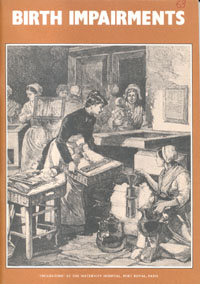Sign up to our newsletter Subscribe
A Spotlight on Haemophilia Therapies

Most of the 600,000 babies born in England and Wales each year are healthy and have before them the prospect of active lives spanning seventy years or more. A proportion of these infants, however, possess impairments, present at or arising during or immediately…
Most of the 600,000 babies born in England and Wales each year are healthy and have before them the prospect of active lives spanning seventy years or more. A proportion of these infants, however, possess impairments, present at or arising during or immediately after delivery which may lead to severe temporary or permanent handicaps. The most frequently occurring of these impairments, involving physical and/or mental disability, are the subject of this paper.
Measuring the incidence of birth defects presents conceptual as well as methodological difficulties but evidence distilled from a large number of epidemiological surveys suggests that between three and four per cent of births are affected each year. Some of the physical deformities are immediately obvious – for example, spina bifida or cleft lip. With other defects detection may be difficult. Certain malformations of the internal organs, such as the heart or kidneys, may show clinical features in the first few days of life but others may remain undiagnosed until discovered by chance during treatment of some ailment, during surgery, or at autopsy. Similarly, conditions resulting from chromosomal abnormalities, of which Down’s syndrome is the most common, are not always apparent at birth.
Birth defects have been observed throughout history, attracting hypothetical explanations and generating superstitious beliefs. Teratology, originally the science of investigating monstrosities, flourished in the first half of the nineteenth century concentrating in particular on the occurrence of conjoined twins and severe malformations not compatible with life. However, attention was centred on anatomical details rather than any concern to understand the causes of these abnormalities which is only relatively recent. Scientific interest developed in animal studies in the 1920s and 1930s. It increased markedly and concerned humans in the early 1940s when a link was conclusively demonstrated between maternal rubella and foetal malformations. Further impetus was generated by the thalidomide experience of the late 1950s/early 1960s and the developments subsequent to it. Current intensification of research reflects the relative increase in the contribution of birth defects to childhood morbidity and mortality patterns brought about by improved obstetric management and by control over the infectious diseases with antibiotics. The factors and mechanisms which deflect foetal development from a normal course remain, as yet, unclear.
The scope for preventing the birth of impaired infants is therefore limited in the present state of knowledge. Nevertheless, the adoption of certain general and specific approaches relating to improved antenatal care and prenatal screening would enhance the possibilities of avoiding at least some of the affected births – in particular those which frequently involve severe handicaps. These measures and the technical, ethical and economic problems to which they give rise form the theme of this paper and are discussed following a study of the incidence and prevalence of birth defects and a brief examination of some of the causes identified so far.
Wells, N.
(1978) Birth Impairments. OHE Series on Health. Available from https://www.ohe.org/publications/birth-impairments/